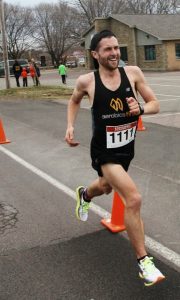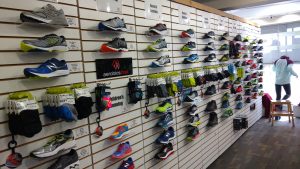My Love Training More coaching partners Janet and Linda and I have been helping a number of our athletes navigate the world of running shoes. We place running shoes on the list of important things that will help a runner pull off a successful training cycle and goal race.

With my eye on helping my runners achieve their best potential, I reached out to two of my Halifax Road Hammer training partners and Aerobics First staff members Matt McNeil and Matthias Mueller for some up-to-date and accurate information on running shoes.
I feel really lucky to be able to publish this valuable and in-depth knowledge about running shoes as well as feet on our Love Training More training blog. Matt, who also happens to be one of Atlantic Canada’s fastest and most accomplished runners, went with a Q & A format with questions from Coach Erin and Coach Janet. I hope you’ll all enjoy and get as much out of this as we did!
1. What are the advantages of having an Aerobics First staff member do an individual shoe fitting with you?
At Aerobics First we are trained to be able to properly fit a runner for a pair of shoes specific to his or her needs and desires. The staff has a diverse understanding of many brands and models of running shoes. The inventory at Aerobics First can accommodate runners of all abilities, whether they’re someone looking to complete their first 5k or looking to conquer an ultra-marathon.
2. What kinds of things do you do when you are fitting a runner with shoes? How do you choose the shoe for them?
We b egin a proper shoe fitting by getting the customer to remove his or her shoes and measuring both of their feet with a Brannock device. Many people have two slightly different sized feet so it is important to use the larger of the two when determining proper running shoe size. At this point it can be helpful to ask the runner questions to learn more about them as a runner and their running history. What are their goals? What is their weekly mileage? Do they have any current injuries or history of injuries? Are they looking for a training shoe or a racing shoe? Are there any particular models of shoes that have worked well for them in the past? The following step is conducting a simple bio-mechanical assessment to determine the level of support the runner will most likely require in their shoe. Watching the customer walk or run and observing the intricacies of their feet can help identify any asymmetries in the customer’s gait and determine what types of shoes would work for best them.
egin a proper shoe fitting by getting the customer to remove his or her shoes and measuring both of their feet with a Brannock device. Many people have two slightly different sized feet so it is important to use the larger of the two when determining proper running shoe size. At this point it can be helpful to ask the runner questions to learn more about them as a runner and their running history. What are their goals? What is their weekly mileage? Do they have any current injuries or history of injuries? Are they looking for a training shoe or a racing shoe? Are there any particular models of shoes that have worked well for them in the past? The following step is conducting a simple bio-mechanical assessment to determine the level of support the runner will most likely require in their shoe. Watching the customer walk or run and observing the intricacies of their feet can help identify any asymmetries in the customer’s gait and determine what types of shoes would work for best them.
3. How do you know if it is a good fit for you? How should it  feel? How would it feel if it is not right for you?
feel? How would it feel if it is not right for you?
We like to say that a good fitting running shoe should fit like a “glove”. It should feel compatible with the shape of your foot and there should be room to wiggle your toes. You do not want to feel like your foot is crammed inside the shoe. There should not be any uncomfortable pressure points or rubbing and it should feel like a good fit prior to leaving the store. A good fitting shoe will often “disappear” on your foot after a a few minutes of wearing it around. Sometimes what feels like a great fit in store may not be the case once you are out running. This is why it is important to take new shoes for a couple trial runs and if they cause any sort of discomfort then they may not actually be the best fit for you. In that case, it would good to try a shoe of comparable style and fit. Finding the right shoe for you may take some time. At Aerobics First we understand this, which is why when we fit runners we allow them to try the new shoes out for a couple runs to see if they will work. If they don’t we can always re-assess and try something different.
4. What are the key differences between the main types of running shoes?
There are 2 main types of running shoes: neutral and stability. Neutral running shoes can be described as the baseline running shoes in terms of support and cushioning. Most runners wear this type of shoe. Runners who do not require any extensive amount of support will fare well in this category. Stability shoes are designed for runners who tend to have “flat feet” or who over-pronate. Pronation is a natural function of the foot and is commonly found in most people. This is often confused with over-pronation which is a tendency for the foot and/or ankle to have a strong medial bias (inward leaning). Over-pronation can occur in flat feet, neutral feet and high-arched feet. Stability shoes are designed to be stiff and have support built into the mid sole to support over-pronation.
 5. How often should you replace your running shoes?
5. How often should you replace your running shoes?
This is a question that is specific to every runner and has no definite answer. It can depend on how many kilometers the runner is logging in the shoes and how frequently those runs occur (every day, every other day, etc.). Types of surfaces can play a role as well. Surfaces like concrete and asphalt are hard and can affect the wear of shoes more so than trails with dirt and crushed gravel which are much softer. The runner’s stride can also affect the wear on a shoe due to the varying impact forces involved while running. Even after taking these variables into consideration it can still be tricky to predict how often you should replace your running shoes. The best advice is to listen to your body. If there haven’t been many drastic changes in your training routine and you start to notice minor aches or pains (shins, knees, ankles, etc.) and you know your shoes are getting old then it could be a good indication that your shoes need to be replaced.
6. Do you have to “break in” new shoes?
In most cases, yes, you should “break in” new shoes. After getting a new pair of running shoes it is ideal to slowly introduce them into your training routine. A new pair of shoes should be introduced into the routine during a relatively short-medium length training run. The reason for this is that newer shoes can be stiff and will not have yet learned to flex and mold with your foot. Introducing them during a shorter run can allow your body time to adapt to a new shoe thus reducing the risk of injury.
7. At what point should you consider owning more than one pair of running shoes?
A good time to have multiple pairs of shoes on the go is when your training routine has some faster sessions (i.e. tempo, fartlek, threshold). It is nice to have a lightweight, firmer shoe for those days as you want the shoe to feel fast and responsive. You can then use your every day trainers for easy/recovery days and long runs as this pair is usually more supportive and cushioned.
8. How many kilometers should you have on your sneakers for your goal half marathon or marathon?
This is another question that will depend on the individual. Most runners will benefit from having anywhere from 50-150km on their shoes prior to their goal half or full marathon, which will have allowed them to fully adapt to their new shoes.
9. How important are properly fitted running shoes in prevention of injuries?
Many different running injuries could be attributed to a runner’s shoes. Although proper fitting running shoes are important to having an injury free career, they are only a small percentage of what can actually be causing a runner’s problems. We highly recommend that runners get assessments from health professionals (i.e. physiotherapists, pedorthists, chiropractors, etc.) to determine any weaknesses or asymmetries in their bodies that could be causing injuries.
A high percentage of runners wear their shoes too small. In proper fitting running shoes there should be approximately a thumb’s width of space between the ends of the toes and the end of the shoe. This is not only to avoid blisters and losing toenails but to allow the foot to properly spread out upon impact. The foot is designed to absorb shock. If the foot doesn’t have adequate space to spread out then it acts rigidly and cannot absorb the forces that are generated during running. When the foot can’t act this way, other areas of the body (whether it’s shins, knees, hips, lower back, etc.) may take some of the force which would otherwise be absorbed by the foot. For example: a common injury in runners that can be traced back to shoes being too small is shin splints. Shin splints can be caused by the constant pounding that running produces and if the foot is not absorbing as much of the impact forces as possible, it places unnecessary strain on other parts of the body such as the shin.
….
Matt, I really believe that the information here will support our community of runners. We are really lucky to have partners like Aerobics First and along with leaders like Matt and Matthias. We deeply appreciate your time.
Runners: you can benefit from Matt, Matthias and the rest of the Aerobics First shoe-fitting expertise at Aerobics First at 6166 Quinpoool Road Monday-Wednesday: 10am – 6pmThursday-Friday: 10am – 9pm Saturday:10am – 5:30pm Sunday: 12pm – 5pm.
Happy running, friends!

